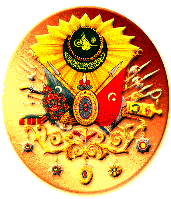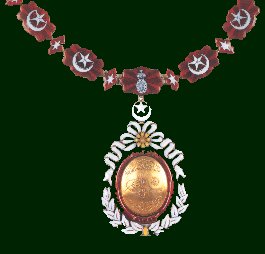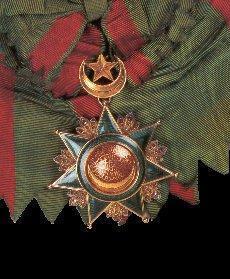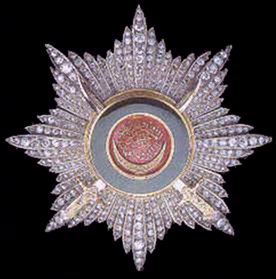TURKEY

BRIEF HISTORY
-
- The
Osmanli Dynasty traces its origins to Osman Khan Ghazi,
founder of the Turkish Empire and son of Ertugrul, leader
of the Kayi clan of the Oghuz tribe, during the late 13th
century. The tribe reputedly descends from Noah, through
his grandson, Oghuz.
-
- Osman's
successors remained conquerers for several generations,
ever extending the boundaries of their Empire on all
sides. The conquest of Constantinople in 1453, though the
jewel in the crown and the pride of their posessions, did
not serve as the culmination of their efforts. Baghdad,
Jerusalem, Mecca and Medina, the Lavant, Syria,
Mesopotamia, Egypt, Libya, Arabia, Algeria, Tunisia, the
Crimea, Greece and the Balkans, and parts of Hungary all
fell to their sway. The Osmanli dynasty had secured, for
themselves, the position of the greatest Islamic dynasty
in history. On two occasions, they threatened Western
Europe itself. Vienna, capital of the Holy Roman Empire,
faced two bitter sieges in 1529 and 1683. However, the
failure of the last, proved to be the nadir of the
empire.
-
- The
eighteenth and nineteenth centuries provided a long
period of slow decline. New or re-invigorated European
powers, in the form of Russia and Austria gnawed away at
the western provinces of the Empire. In time this
encouraged many of the subject races to assert their
independence. By the end of the nineteenth century most
of the European and Caucasian territories had been lost,
save Bosnia, Albania, Macedonia and some parts of modern
day Greece and Bulgaria. In the southern Meditterranean,
Egypt and Cyprus were under British control, Crete and
Samos under international supervision, and Algeria and
Tunisia were under the French.
-
- The
dawn of the twentieth century saw further reverses and
losses of territory in the Balkans, leaving Albania a
lawless land, cut-off from Turkey proper. Italy entered
the general scramble, siezing Rhodes and the Dodecanese
and invading Cyrenaica and Tripoli. On the eve of the
Great War, the first stirrings of the Arab renaissance
were becoming apparent. Jewish migration and settlement
in Palestine increased rapidly. The sick man of Europe
was clearly on its last legs.
-
- Disasterously,
though perhaps understandably, the rulers of Turkey chose
to side with the Central European powers on the outbreak
of War. Believing in the magic of the Khalifate they
proclaimed Holy War, expecting Muslims under British,
French and Russian rule to rize up in their defence.
Quite the reverse ensued. Not only did they fail to rise
to the defence of the Khaliphate; they contributed very
significantly in ensuring that their rulers would be
victorius. Surrounded by enemies on all sides, Turkey saw
its remaining subject peoples throwing in their lot with
the allies, in hope of achieving nationhood.
-
- Wars
end left Turkey with little more than Turkey proper,
Armenia and parts of Kurdistan. Nationalist generals,
including Mustafa Kemal, seized power in the rest of the
country and began a process of consolidating their
position. When the old Sultan Muhammad V died in 1918,
they saw their chance. The allies had occupied the seat
of the Sultan, cutting him off from the rest of the
country. A successful war against Greece entrenched the
military oligarchy in the positions. They established
their capital at Angora (Ankara) and began chipping away
at the monarchy. After four years of steady effort, they
succeeded in removing Sultan Muhammad VI from all
temporal authority in the state. He abdicated in disgust
and went into exile.
-
- The
anti religious Ankara regime then secured the election of
Sultan 'Abdu'l-Majid Khan I as Khalif by the National
Assembly in 1922. Clearly meant as a sop to secure the
loyalty of tradional minded elements within the country,
they tired of their own fiction within two years. They
abolshed the Kaliphate and expelled the entire Ottoman
dynasty on the 3rd ofMarch 1924. The regime
then established the Turkish republic with Mustafa Kemal
Pasha, transformed into Kemal Ataturk, as President,
Father of the Nation and dictator, with democratic
pretensions.
-
- After
their expulsion from Turkey, the Imperial family
dispersed to several destinations, San Remo and the South
of France, Beirut and Alexandria, being the favoured
places of exile. They were not permitted to return to
Turkey until 1953, when Ataturk and his lieutenants were
safely at peace with his maker.
-
- STYLES
AND TITLES:
- The
Sovereign: Sultan (given name) Khan, Sovereign of the
House of Osman, Sultan of Sultans, Khan of Khans,
Commander of the Faithful and Successor of the Prophet of
the Lord of the Universe, Protector of the Holy Cities of
Mecca, Medina and Jerusalem, Emperor of The Three Cities
of Constantinople, Andrinopole and Bursa, and of the
Cities of Damascus and Cairo, of all Azerbaijan, of the
Magris, of Barka, of Kairuan, of Aleppo, of Arabic Iraq
and of Ajim, of Basra, of El Hasa, of Dilen, of Raka, of
Mosul, of Parthia, of Diyarbakir, of Cicilia, of the
Vilayets of Erzurum, of Sivas, of Adana, of Karaman, Van,
of Barbary, of Abyssinia, of Tunisia, of Tripoli, of
Damascus, of Cyprus, of Rhodes, of Candia, of the Vilayet
of the Morea, of the Marmara Sea, the Black Sea and also
its coasts, of Anatolia, of Rumelia, Baghdad, Kurdistan,
Greece, Turkistan, Tartary, Circassia, of the two regions
of Kabarda, of Georgia, of the plain of Kypshak, of the
whole country of the Tartars, of Kefa and of all the
neighbouring countries, of Bosnia and its dependencies,
of the City and Fort of Belgrade, of the Vilayet of
Serbia, with all the castles, forts and cities, of all
Albania, of all Iflak and Bogdania, as well as all the
dependencies and borders, and many others countries and
cities.
- The
Heir Apparent: Daulatlu Najabatlu Vali
Ahad-i-Sultanat (given name) Effendi Hazlatlari,
i.e. Crown Prince, with the style of His Imperial
Highness.
- The
senior wives of the Heir Apparent: Vali Ahad Zevcesi,
equivalent to Crown Princess, but not normally
translated.
- The
mother of the reigning Sovereign: Daulatlu Ismatlu (given
name) Validi Sultana 'Aliyat us-Shan
Hazratlari, with the style of Her Majesty.
- The
first four official wives of the Sovereign, according to
Islamic law: Daulatlu Ismatlu (given name) Bash
Kadin Effendi Hazratlari, Daulatlu
Ismatlu (given name) 2nd Kadin Effendi
Hazratlari, Daulatlu Ismatlu (given name) 3rd
Kadin Effendi Hazratlari, and Daulatlu
Ismatlu (given name) 4th Kadin Effendi
Hazratlari, with the style of Her Majesty.
They were additionally styled Haseki Sultana if
they had born a son to the Sultan, Haseki Kadin Effendi
if they had only borne daughters.
- The
next four favourite wives of the Sovereign: Daulatlu
Bash Iqbal (given name) Khanum Effendi
Hazratlari, Daulatlu 2nd Iqbal (given name) Khanum
Effendi Hazratlari, Daulatlu 3rd Iqbal (given
name) Khanum Effendi Hazratlari, and
Daulatlu 4th Iqbal (given name) Khanum Effendi
Hazratlari, with the style of Her Highness. Usually
promoted to official wife (Kadin Effendi),
on the death of one of the latter. Also borne by the
mothers of sons of a Sovereign.
- The
next four ladies of the Sovereign's harem: styled (given
name) Bash Gozde, 2nd Gozde, 3rd
Gozde, and 4th Gozde.
- The
next four junior ladies of the Sovereign's harem: styled
(given name) Bash Paik, 2nd Paik, 3rd
Paik, and 4th Paik.
- Male
descendants of a Sovereign in the male line: Daulatlu
Najabatlu Shahzada Sultan (given name) Hazretleri
Effendi, i.e. Prince (given name) Effendi, with the
style of His Imperial Highness.
- Female
descendants of a sovereign in the male line: Daulatlu
Ismatlu (given name) Sultana 'Aliyat
us-Shan Hazratleri, i.e. Princess with the style of Her
Imperial Highness.
- The
first four official wives of Imperial Princes: (given
name) Khanum Effendi Effendi Hazratlari.
- The
husbands of Imperial Princesses: Damad-i-Shahyari
(given name) Bey Effendi, the latter, only if not
posessed of a higher rank or title, with the style of His
Highness.
- The
sons of Imperial Princesses: Sultanzada (given
name) Bey-Effendi, i.e. Prince, with the style of His
Highness.
- The
sons of Imperial Princesses: (given name) Khanum-Sultana,
i.e. Princess, with the style of Her Highness.
- The
grandsons of Imperial Princesses in the male line: (given
name) Bey.
- The
granddaughters of Imperial Princesses in the male line:
(given name) Khanum.
-
- RULES
OF SUCCESSION:
- Hereditary,
in order of birth, from one brother to the next, or one
cousin to another, until all the survivors of a
generation have succeeded in turn. On the death of the
last brother, the succession passes to the eldest born
son of the deceased males of the previous generation (not
necessarily the eldest son of the eldest brother).
-
- ORDERS
AND DECORATIONS:
- The
Exalted Order of the House of Osman (Hanedan-i-Ali-Osman
Nishani): founded by Sultan 'Abdu'l-Hamid Khan
II on 31st August 1893. Awarded in one class
(in brilliants), to senior male and female members of the
Imperial family and foreign heads of state. Only 50 sets
were awarded between 1893 and 1922.
-

Badge and Collar
(Copyright© H.M. The Queen)
- The
Order of the August Portrait (Tasvir-i Humayun
Nishani): founded by Sultan Mahmud II in 1832.
Awarded in one class (in brilliants).
- The
Order of Ertugrul (Ertogrul Nishani): founded by
Sultan 'Abdu'l-Hamid Khan II on 26th February
1903.
- The
Order of the Red Crescent (Hilal Nishani): founded
by Sultan Selim Khan III Ilhami in 1790. Conferred on
foreigners for services rendered during the Napoleonic
wars, but fell into disuse.
- The
Order of Glory (Atiq Nishan-i-Iftikhar): founded
by Sultan Mahmud Khan II on 19th August 1831.
Awarded in one class (in brilliants). A medal of the
order was instituted in 1887.
-


Badge and Star (Copyright©
Sotherby's London)
- The
Exalted Order of Honour (Nishan-Ali-Imtiaz): First
founded by Sultan 'Abdu'l-Majid Khan I and revived and
reformed by Sultan 'Abdu'l-Hamid Khan II on 17th
December 1878. Awarded in one class (in brilliants). A
medal for gallantry was attached to the order from 11th
September 1883 and awarded in gold and silver.
- The
Order of Excellence (Maziyyat Nishani): founded
by Sultan Muhammad V Rashad Khan on 3rd May
1910. Awarded in five classes.
- The
Imperial Order of Osmania or the Osmans (Nishan-i-Osmania):
founded by Sultan 'Abdu'l-Aziz Khan I on 9th
December 1861. Awarded in three classes from its
inception, extended to four classes and an additional
class in brilliants, in 1867.
-


1st class Badge
(Copyright© H.M. The Queen). xx
Murassa Military star
(Copyright© John D. Clarke)
- The
Imperial Order of the Majidi or Nobility (Nishan-i-Majidia):
founded by Sultan 'Abdu'l-Majid Khan on 17th
September 1852. Awarded in five classes with an
additional class is brilliants. Conferred on both ladies
and gentlemen.
-

3rd class Badge
(Copyright© C.M. King)
- The
Order of Charity (Nishan-i-Shafakat): founded by
Sultan 'Abdu'l-Hamid Khan II in September 1878 and
awarded in three classes to ladies, the first two classes
in brilliants.

1st class Star (Copyright©
C.M. King)
- The
Order of Education (Ma'araf Nishani):founded by
Sultan Muhammad V Rashad Khan on 3rd May 1910.
Awarded in three classes, all recipients being required
to ascend from the lowest class.
- The
Parliamentary Order: (Majlisi Mabusan Azalarina
Mahsus Nishan): founded by Sultan Muhammad V Rashad
Khan in 1914.
-
- GLOSSARY:
- Agha (or
Agha): commander, a title junior to Bey and conferred on
military officers on a personal basis.
- Alp:
brave warrior, a title coferred during the early years of
Ottoman rule.
- Amir
ul-Muminin: Commander of the Faithful, one of the
many titles of the Sultan of Turkey.
- Bey: a
title junior to Pasha and conferred on civil and military
officers on a personal basis; also borne as a curtesy
title for the sons of a Pasha.
- Bey Effendi:
part of the title of a husband and sons of an Imperial
Princess.
- Beylerbeyi
(or Beglerbegi): Lord of Lords. An office signifying rule
over a great province, equivalent to Governor-General.
The office entitled the holder to the personal title of Pasha.
- Beyzade:
son of a Bey, a courtesy title borne by a son of a Bey
Effendi.
- Bimbashi:
Major (army) or Commander (navy). The holder of the rank
enjoyed the title of Effendi.
- Khalif
(also Caliph or Khalifa): Successor (of the Prophet).
- Khalif
ur-Rasul Rub al-A'alimin: Successor of the Prophet of
the Lord of the Universe. The highest earthly title of
the Muslim world, enjoyed by the Sultans of Turkey after
their conquest of Egypt in 1517.
- Damad (or
Damad-i-Shahriyari): Imperial son-in-law, title conferred
on the husbands of Imperial Princesses.
- Effendi:
master, title equivalent to Esquire; frequntly used
together with higher titles in order to indicate signify
enhanced status. Used by the sons of Sultans from the
reign of Sultan 'Abdu'l Majid I.
- Ferik:
Lieutenant-General (army) or Vice-Admiral (navy). The
holder of the rank enjoyed the title of Pasha.
- Firman:
Imperial decree or edict.
- Ghazi:
victorious, a title conferred on leaders who
distingusihed in war.
- Gözde:
noticed (by the Sultan). Style borne by junior ladies of
the Harem when first gaining favour from the Sultan.
- Khadim
ul-Haramain us-Sharifain: Protector of the Holy
Cities of Mecca and Medina, a title awarded to Salim I by
the Sherif of Mecca.
- Haji (or
Hacci): honorific used for men who have made the
pigrimage to Mecca.
- Hakhan
ul-Barrayun wa al-Bahrain: Lord of the Lands and
Seas, one of the many titles of the Sultan.
- Harem (or
Haram): fobidden, term used by Europeans to collectively
describe the wives and concubines in a Muslim household.
- Haseki Kadin
Effendi: Lady favourite, title borne by junior ladies
of the Harem, who had borne a daughter to a Sultan.
- Haseki
Sultana: Princess favourite, title borne by junior
ladies of the Harem, who had borne a son to a Sultan,
usually limited to the first four or six to become
mothers.
- Hazretleri:
style equivalent to Highness.
- Jihad:
Holy War.
- Kaimakam:
Lieutenant-Colonel (army) or Commander (navy).The holder
of the rank enjoyed the title of Bey.
- Khan (or
Hân): a title signifying sovereign or ruler in Turkey,
but a very junior title signifying a male noble, or even
a mere name, in other parts of the Muslim world.
- Khakhan:
Khan of Khans, one of the many titles of the Sultan of
Turkey.
- Khanum:
female of Khan, equivalent to Lady.
- Khanum
Effendi: title borne by the official wives of
Imperial Princes.
- Khanum
Sultana: Princess Lady, title borne by the daughters
of Imperial Princesses.
- Kizlar Aghasi:
Chief of the Eunuchs. The office entitled the holder to
the style of His Highness.
- Iqbal (or
Ikhal): fortunate, title borne by the favourite Harem
ladies of a Sultan.
- Iqbal Effendi
(or Ikhal Effendi): title borne by an official favourite
wife of a Sultan.
- Kapudan Pasha:
Grand Admiral or Admiral of the Fleet.The holder of the
rank enjoyed the title of Pasha.
- Lewa (or
Liva): Major-General (army) or Rear-Admiral (navy).The
holder of the rank enjoyed the title of Pasha.
- Mahd-i
Ulya-i-Sultanat: crade of the great Sultan, another
title for the Sultan's mother.
- Miralai:
Colonel (army) or Captain (navy).The holder of the rank
enjoyed the title of Bey.
- Mulazim Awal:
Lieutenant (army) or Sub-Lieutenant (navy). The holder of
the rank enjoyed the title of Effendi.
- Mulazim Tani:
Second Lieutenant (army) or Midshipman (navy).The holder
of the rank enjoyed the title of Effendi.
- Mushir:
Field Marshal.The holder of the rank enjoyed the title of
Pasha.
- Nishan
(or Nichan): order of chivalry or decoration of honour.
- Padshah
(or Padishah): Emperor, one of the many titles of the
Sultan of Turkey.
- Pasha:
Lord, a title senior to that of Bey and conferred on a
personal basis on senior civil officials and military
officers. Awarded in several grades, signified by a whip,
the highest rank being a whip of five Yaks tails.
- Pashazada:
son of a Pasha, used as an alternative curtesy title to
Bey.
- Sadaf-i-Durr-i-Khilafat:
shell of the pearl of the caliphate, another title for
the mother of the Sultan.
- Saraskar:
C-in-C.
- Shah:
King, title of Persian origin.
- Shah-i-Alam
Panah: King, refuge of the world, one of the titles
of the Sultan.
- Shahzada (or
Shahzade): son of the King, title used for the sons of
Sultans from the reign of Muhammad I.
- Shahzada
Hazratlari (or Shahzade Hazretleri): Imperial
Highness.
- Shaikh
ul-Islam: the title held by the highest ranking
Muslim religious official below the Khalif. The office
entitled the holder to the personal title of Pasha together
the style of His Highness.
- Shalabi (or
Cecebi): gracious lord, title borne by sons of the Sultan
until the reign of Muhammad II.
- Silahadar:
Master-General of the Ordnance.
- Sipah Salar:
General of Cavalry.
- Sultan:
title borne by male members of the Imperial family,
particularly after then reign of Muhammad II. When it is
used before the given name, together with Khan after the
name, it signifies ruler. When used before the name,
Imperial Prince. When used after the name, Imperial
Princess.
- Sultan Khan:
The Grand Sultan, the chief title borne by the ruler of
Turkey and the Ottoman empire, equivalent to Emperor.
- Sultana:
title of an Imperial Princess.
- Sultan
us-Selatin: Sultan of Sultan, one of the many titles
of the Sultan of Turkey.
- Sultanzada (or
Sultanzade): son of a Sultan, the title borne by the sons
of Imperial Princesses.
- Tughra:
the distinctive monogram of a Sultan.
- Vali:
Governor. The office entitled the holder to the personal
title of Pasha.
- Vali Ahad
(or Veliaht): Heir Apparent or Presumptive usually
translated as Crown Prince.
- Vali Ahad
Zevcesi: Heir Apparent's wife, the title borne by the
official wifes of the Heir Apparent, equivalent to Crown
Princess but not usually translated.
- Valide
Sultana: Princess Mother, the title borne by the
mother of a reigning Sultan.
- Vizier:
bearer of the burden, i.e. Minister.
- Vizier-i-Azam:
Grand Vizier, the title borne by the incumbant Prime
Minister. The office entitled the holder to the personal
title of Pasha together the style of His
Highness.
- Yuzbashi
(or Youzbashi): Captain (army) or Lieutenant (navy).The
holder of the rank enjoyed the title of Effendi..
-
- SOURCES:
- A.D.
Alderson, The Structure of the Ottoman Dynasty. Clarendon
Press, Oxford, 1956.
- Almanach
de Gotha: annuaire généalogique, diplomatique et
statistique, Justes Perthes, Gotha, 1880-1944.
- Burke's Royal
Families of the World, Volume II: Africa & The Middle
East, Burke's Peerage Ltd., London, 1980.
- Philip Mansel,
Sultans in Splendour. André Deutsch Limited, London,
1988.
- Yilmaz Oztuna,
Devletler ve Hanedanlar Turkiye 1074-1990. Ankara, 1989.
- Julian
Raby (ed.), The Sultan's Portrait; Picturing the House of
Osman. Turkiye Is Bankasi, Istanbul, 2000.
- Osman
Selaheddin Osmanoglu, Osmanli Devleti'nin Kurulusunun
700. Yilinda Osmanly Hanedani. Islam Tarih, Sanat ve
Kultur Arastirma Vakfi (ISAR), Istanbul, 1999.
- Emine
Fuat Tugay, Three Centuries: Family Chronicles of Turkey
and Egypt. Oxford, 1963.
- Prof.
Ismail Hakki Uzuncarsili (ed.), Osmanli Tarihi: Volumes
1-10. Turk Tarih Kurumu Basimevi, Ankara, 1988-1998.
-
-
- I
would be grateful to hear from anyone who may have
changes, corrections or additions to contribute. If you
do, please be kind enough to send me an e-mail using the
contact details at: Copyright©
Christopher Buyers
-
Copyright©Christopher
Buyers, December 2000 - April 2003







